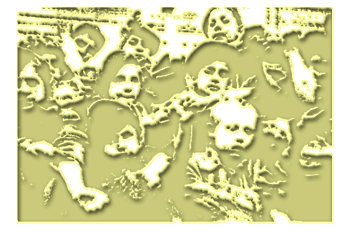 |
 |
 |
|
|||
|
Keeping the Memory Alive If you grew up Jewish in Skokie during the 1960s, as I did, the voice of Adolph Hitler still echoed. Our neighbors were the Herskovitzes, and they had survived the concentration camps. I remember as a little boy going over to pay them a visit, and Bea, Mrs. Herskovitz, brought me into her kitchen and offered up some milk and cookies. As she reached across the table to put down a plate, the sleeve of her shirt hiked up, revealing a row of black numbers forever etched into her flesh. I'll never forget that moment. It was my introduction to the holocaust. The Herskovitzes were among the 7,000 or so Holocaust survivors who lived in Skokie at the time. And along with the survivors were the families of those who had perished. The Holocaust Monument that now stands in Skokie pays homage to these families, to the memories of the mothers, fathers, grandparents, aunts and uncles who were murdered by the Nazis. For the tourist visiting Chicago, the monument is easy to get to. Take the 'L' to the Howard Street station, and hop on the bus to Oakton Street in downtown Skokie. The monument is on the village green, and a visit there opens a window into the past. The statue depicts a small group, the tallest among them a Jewish freedom fighter. A belt of bullets hangs round his neck like a sash of honor. His face is strong and angry but gripped with anguish, his arms outstretched, shielding his flock: a bearded grandfather dressed in the garb of the Shtetl; a terrified young boy who clings to the grandfather; and a mother, brought to her knees with a limp, lifeless child in her arms.
Felicia Brenner lives a short walk from the Holocaust Monument. She is a striking woman, with a shock of black hair, sharp, knowing eyes, and a porcelain face that conveys dignity and calm. Mrs. Brenner is an activist. She speaks to students about the Holocaust. And she also writes poetry.
Ask Felicia Brenner to talk about the Holocaust Monument, to tell you the story behind it, and she remembers the time the Nazis came to town, or at least tried to. It was 1977, and Skokie was about to experience a wrenching crisis that would pit history, morality and a search for justice against nothing less than the First Amendment of the Constitution of the United States.
Gathered in the Mayors office were officials from the Skokie park district, who had brought with them a letter from Frank Collin requesting a permit to allow him and his group to demonstrate in the village of Skokie on May 1st, 1977, at three in the afternoon.
Frank Collin spoke of Jewish people at a press interview, where he invoked the words of a Roman historian.
The prospect of jackbooted Nazis displaying the swastika on the steps of Skokie's village hall galvanized the village's Holocaust survivor community. Felicia Brenner:
Meetings were organized. Letters were written to officials and to the newspapers. One of the leaders of the anti-Nazi movement received threatening phone calls late at night. This man had survived Auschwitz and Buchenwald. He agrees to speak only anonymously, for he fears, even now, in the year 2000, a new round of threats if his name is broadcast.
This man, whom we'll call Jacob, said the planned Nazi march brought him back to Hitler's Europe in 1939.
In April 1978, after endless court battles, the Federal Circuit Court in Chicago ruled in favor of Frank Collin's right to demonstrate in Skokie. The court held that the wearing of Nazi armbands and the display of the Nazi flag is a constitutionally protected free expression. A First Amendment exercise in its most pristine and classic form. A final appeal by Skokie to the U.S. Supreme Court was rejected. The Nazis could march. And everybody expected there would be violence. Barry Silverberg was a young officer on the Skokie police force in April 1978.
At the end of the day, having won the right in court to demonstrate in Skokie, Frank Collin went before the press.
Skokie's attorney, Harvey Schwartz, says Collin decided to stay away from Skokie because he was afraid.
Instead, Collin and a handful of supporters got permission to march in Chicago, at the Federal Plaza and in Marquette Park. And, according to Harvey Schwartz, Skokie's Holocaust survivor community felt vindicated.
In 1987, nine years after Frank Collin won the right to march in Skokie, the Holocaust Monument was set into place on the village green. The drive to erect the monument was led by Skokie's Holocaust survivors, who had, in their fight against Frank Collin, found a new, collective voice, a strong public voice that wanted to be heard, that wanted people to remember. Rabbi Lawrence Montrose was at the dedication ceremony.
On the night of its dedication, the Holocaust Monument was desecrated with swastikas.
Jacob is one of the leaders of the survivor community.
After a few days, the swastikas were cleaned off, and now the monument still stands, untainted on the village green. It is a worthy tourist destination, located right next to the ground Frank Collin once sought to march upon. The monument, like free speech, is etched into the Skokie landscape. It is a reminder of unthinkable injustice, a memorial to the vanquished six million, and most of all, a salve on the wounds of all who have survived. From Skokie, this is Robert Rand for The Savvy Traveler.
|
 | American Public Media Home | Search | How to Listen ©2004 American Public Media | Terms of Use | Privacy Policy |


